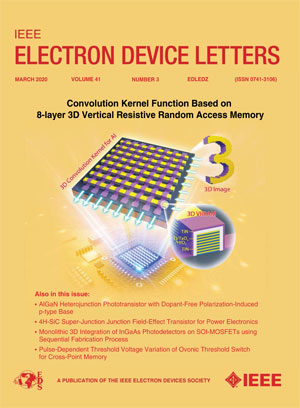VLWIR阻塞杂质带光电探测器的界面控制性能
IF 4.5
2区 工程技术
Q2 ENGINEERING, ELECTRICAL & ELECTRONIC
引用次数: 0
摘要
高灵敏度甚长波长红外阻挡杂质带(BIB)光电探测器是大气监测和天文观测的重要组成部分。然而,传统BIB模型与实际BIB结构之间存在差距,界面效应也没有得到明确。本文提出了一种BIB界面模型,并通过仿真和实验阐明了界面层的势垒分布及其对光电探测器工作时暗电流和响应的影响。制备并分析了具有尖锐界面和渐变界面的掺磷硅BIB结构。实验结果表明,尖界面BIB光电探测器的暗电流降低了5个数量级,在正向偏置下将暗电流保持在1 pA以下,最高可达2.7 V,在28.3~\mu $ m处的峰值黑体探测率超过$1\ × 10^{{12}}$ cm Hz1/2·W−1。相比之下,渐变界面光电探测器提高了对较长波长的低能光子的探测。这些发现为BIB光电探测器的界面工程提供了重要的见解,并为优化VLWIR探测性能提供了指导。本文章由计算机程序翻译,如有差异,请以英文原文为准。
Interface-Controlled Performance in VLWIR Blocked Impurity Band Photodetectors
High-sensitivity very long-wavelength infrared (VLWIR) blocked impurity band (BIB) photodetectors are essential for atmospheric monitoring and astronomical observation. However, there is a gap between the traditional BIB model and the actual BIB structure, and the interface effects have not been clarified. In this work, a BIB interface model is proposed, and the potential barrier distribution of the interfacial layer and its influence on the photodetector dark current and response during operation are clarified through simulations and experiments. Phosphorus-doped silicon BIB structures with sharp and gradual interfaces were fabricated and analyzed. Experimental results demonstrate that sharp interface BIB photodetectors achieve five orders of magnitude reduction in dark current, maintaining dark current below 1 pA at forward bias up to 2.7 V, and achieving a peak blackbody detectivity exceeding $1\times 10^{{12}}$ cm Hz1/2·W−1 at $28.3~\mu $ m. In contrast, gradual interface photodetectors improved the detection of low-energy photons at longer wavelengths. These findings provide critical insights into interface engineering in BIB photodetectors and offer guidelines for optimizing VLWIR detection performance.
求助全文
通过发布文献求助,成功后即可免费获取论文全文。
去求助
来源期刊

IEEE Electron Device Letters
工程技术-工程:电子与电气
CiteScore
8.20
自引率
10.20%
发文量
551
审稿时长
1.4 months
期刊介绍:
IEEE Electron Device Letters publishes original and significant contributions relating to the theory, modeling, design, performance and reliability of electron and ion integrated circuit devices and interconnects, involving insulators, metals, organic materials, micro-plasmas, semiconductors, quantum-effect structures, vacuum devices, and emerging materials with applications in bioelectronics, biomedical electronics, computation, communications, displays, microelectromechanics, imaging, micro-actuators, nanoelectronics, optoelectronics, photovoltaics, power ICs and micro-sensors.
 求助内容:
求助内容: 应助结果提醒方式:
应助结果提醒方式:


